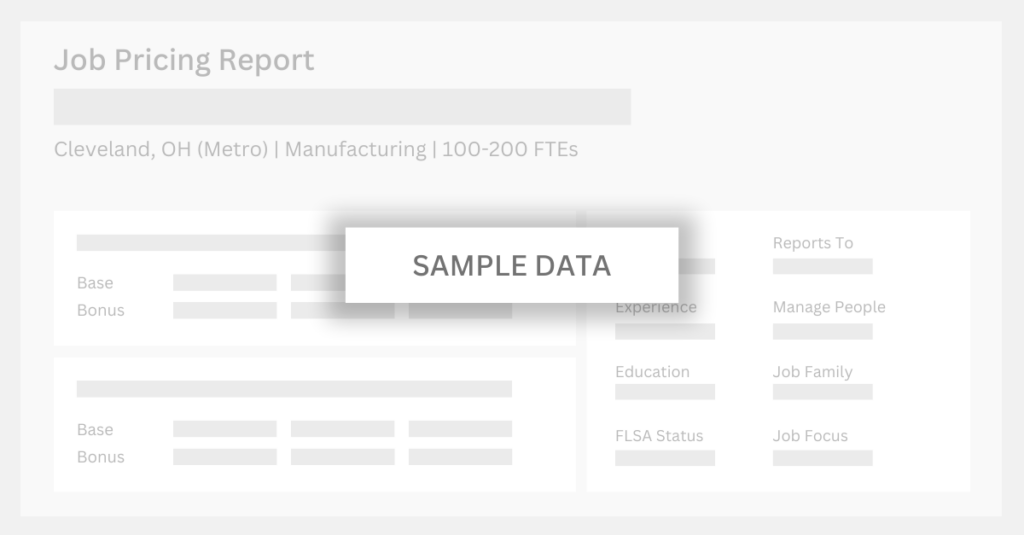Compensation Data for an HR Manager in Ohio

Compensation data breakouts:
- Location (example: Cleveland, Akron, Ohio, National)
- Company Size (number of full-time employees)
- Industry (industry-specific or all industries)
- Years of Experience
- Education
Data included in each report:
- Base Compensation (Salary or Wage)
- Total Compensation
- Bonus
- Long-term Incentives
- Job Description
- Competencies/Skills
Get a Free Sample Report
Submit the form below to receive a sample job pricing report or to access ERC’s compensation data.

ERC is a leading provider of compensation data
Whether you’re actively recruiting and hiring or trying to stay competitive, having local salary and wage data is critical. ERC members gain access to compensation reports, job description research, and an HR Help Desk for compensation and workplace practices data.
Job Description
Overview
- Manages Human Resources staff and plans, develops, recommends, and implements human resources activities, policies, procedures, and programs for an organization, assisting upper management as requested.
- Manages activities relating to staffing, employee education and training, management development, labor relations, affirmative action, benefits administration, and salary administration.
Typical Functions
- Plans and conducts new employee orientation to foster positive attitude toward company goals.
- Keeps records of insurance coverage, pension plan, and personnel transactions, such as hires, promotions, transfers, and terminations.
- Investigates accidents and prepares reports for insurance carrier.
- Participates in compensation and benefit surveys and/or conducts wage survey within labor market to determine competitive wage rate and remain apprised of current trends.
- Writes separation notices for employees separating with cause, and conducts exit interviews to determine reasons behind separations.
- Prepares reports and recommends procedures to reduce absenteeism and turnover.
- Hires, trains, evaluates employee performance, and recommends or initiates promotions, transfers, and disciplinary action.
- Prepares and analyzes department budget to identify budget needs and/or reductions, and may allocate operating budget funds.
- May represent company at personnel-related hearings and investigations.
- May contract with outside suppliers to provide employee services such as food services, transportation, or relocation service.
- May administer pre-employment tests to applicants.
- May supervise clerical workers.
- May keep records of hired employee characteristics for governmental reporting purposes.
- May negotiate collective bargaining agreement.
- May include management of employee relations activities.
Similar Positions
There are several positions that share similar responsibilities to an HR Manager, including:
- HR Director
- HR Business Partner
- HR Generalist
- Talent Acquisition Manager
- Compensation and Benefits Manager
- Employee Relations Manager
- Organizational Development Manager
- HR Operations Manager
Experience and Education
An HR Manager typically needs a combination of education and experience in the field of human resources. They should have a bachelor’s degree in human resources, business administration, or a related discipline. Practical experience gained through internships, entry-level HR roles, or HR certifications such as Professional in Human Resources (PHR) or Senior Professional in Human Resources (SPHR) is highly valuable.
HR Managers should have a strong understanding of HR policies, practices, and employment laws. They should be knowledgeable about various HR functions, including recruitment, employee relations, performance management, compensation and benefits, and HR compliance. Experience in managing employee issues, leading HR initiatives, developing HR programs, and collaborating with cross-functional teams is essential. Strong interpersonal, communication, and leadership skills are critical for effectively managing and supporting the organization’s human capital needs.
Competencies and Skills
- HR knowledge
- Employee relations
- Recruitment and selection
- Performance management
- Compensation and benefits
- HR compliance
- HRIS and technology
- Training and development
- Change management
- Employee engagement
FAQ
The main difference between an HR Manager and an HR Director lies in the scope and level of responsibility. An HR Manager typically oversees and manages the day-to-day operations of the human resources function within an organization. They are involved in implementing HR policies, managing employee relations, overseeing recruitment and selection processes, and handling HR administrative tasks.
On the other hand, an HR Director holds a more senior-level position and is responsible for the strategic direction and overall management of the HR department. They focus on setting HR goals aligned with organizational objectives, developing HR strategies, and leading initiatives that impact the entire workforce. HR Directors often have a broader influence on shaping HR policies, driving organizational culture, and collaborating with top-level management. They may also have additional responsibilities, such as managing HR budgets, guiding HR teams, and ensuring compliance with legal and regulatory requirements.
Through frequent polls and surveys, ERC offers a comprehensive collection of recent, reliable data covering workplace practices, employee compensation, benefits, wages, and salaries from local, regional, and national samples.
While “free” compensation data can be found on the web, here’s why you should be cautious:
- Validity — Often “free” salary data is collected from anyone willing to participate or share information. This means you don’t have a good sense of how big the sample size is, the geography of the data, or the type or size of organizations from which the data is being collected.
- Recency — ERC’s survey data relies on regular and consistent participation to ensure that the data is recent, while “free” pay data sources may provide data that is many years old.

